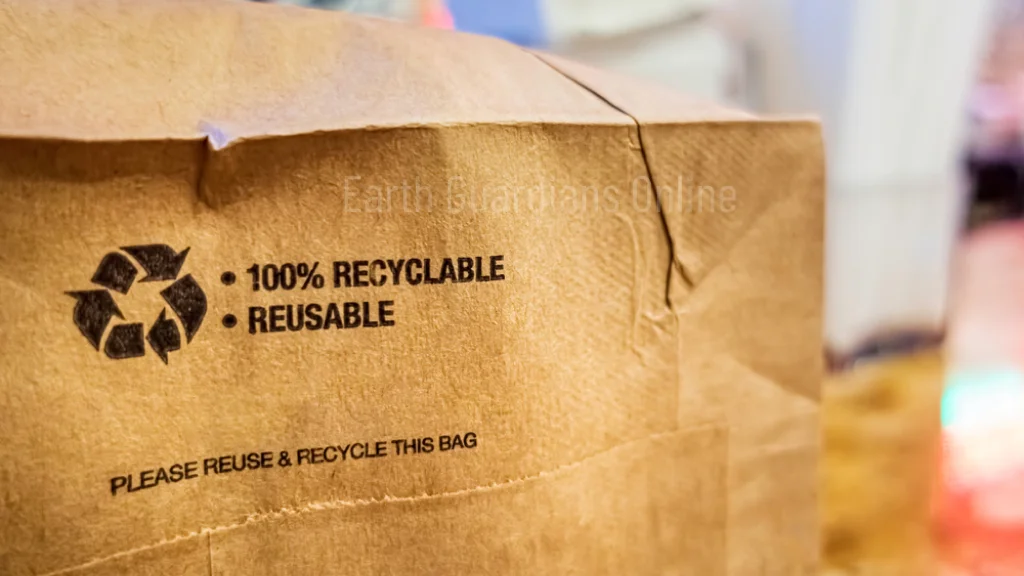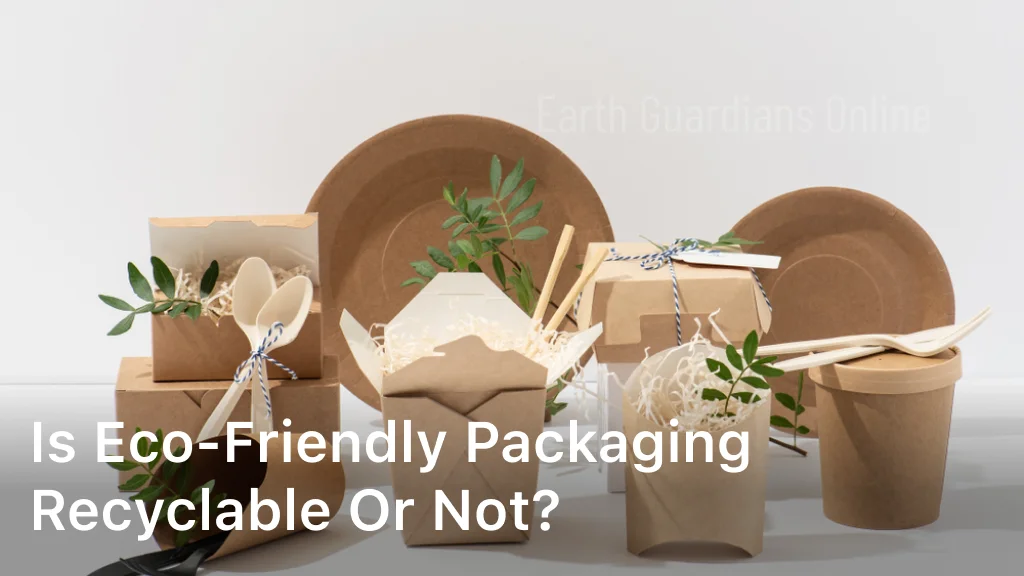earthguardiansonline.com. Is Eco-Friendly Packaging Recyclable or Not? – Find out as we delve into the question, “is eco-friendly packaging recyclable?” Unveiling truths about sustainable packaging in the US.
As more consumers and businesses prioritize sustainability, the use of eco-friendly packaging has become increasingly popular. However, a common question arises – is eco-friendly packaging recyclable? In this article, we will explore the topic of eco-friendly packaging and its recyclability.
Key Takeaways
- Eco-friendly packaging is a sustainable alternative to conventional packaging.
- The recyclability of eco-friendly packaging depends on the materials used and the recycling facilities available.
- Advancements have been made in recycling eco-friendly packaging, but there are still limitations and challenges.
- Recycling eco-friendly packaging has environmental benefits, but it is important to reduce waste and promote reuse as well.
- Consumers and businesses can play a role in promoting recycling and sustainability in packaging practices.
Table of Contents
ToggleIs Eco-Friendly Packaging Recyclable or Not?
Eco-friendly packaging is designed to have minimal impact on the environment, and it often includes materials that are recyclable, biodegradable, or made from renewable resources. However, the recyclability of eco-friendly packaging depends on the specific materials used and the recycling infrastructure in a particular area.
Many eco-friendly packaging options, such as paper, cardboard, and certain types of bioplastics, can be recycled. However, it’s essential to check the specific guidelines of your local recycling program, as different facilities may have varying capabilities and requirements.
Here are some common eco-friendly packaging materials and their recyclability:
- Paper and Cardboard: These materials are widely recyclable. They can be collected and processed at recycling facilities to produce new paper and cardboard products.
- Bioplastics: Some bioplastics are designed to be compostable or recyclable. However, not all bioplastics are accepted by standard recycling facilities. Look for certifications like “compostable” or “recyclable” and follow local guidelines.
- Glass: Glass is 100% recyclable and can be recycled endlessly without loss of quality. It is a commonly used eco-friendly packaging material.
- Metal: Aluminum and steel are highly recyclable materials. Recycling metal requires less energy compared to producing new metal, making it an eco-friendly option.
- Certain Plastics: Some types of plastics are recyclable, such as PET (polyethylene terephthalate) and HDPE (high-density polyethylene). Check the recycling symbol on the packaging and local recycling guidelines.
It’s important to note that contamination can impact the recyclability of materials. Ensure that packaging is clean and free of food residue before placing it in recycling bins.

Understanding Eco-Friendly Packaging
Eco-friendly packaging is becoming increasingly popular due to its positive impact on the environment. It differs from conventional packaging in that it is designed to be sustainable, meaning it has minimal impact on the earth’s resources and can be recycled or disposed of safely.
There are several materials used to create sustainable packaging, including:
| Material | Description |
|---|---|
| Bioplastics | Derived from renewable resources such as cornstarch and sugarcane, bioplastics are biodegradable and compostable. |
| Recycled paper | Paper products made from recycled materials, reducing the need for new trees to be cut down. |
| Mushroom packaging | Made from mycelium, the vegetative part of mushrooms, this material is biodegradable and compostable. |
| Plant-based packaging | Materials such as bamboo, hemp, and cotton can be used to create packaging that is biodegradable and compostable. |
Creating eco-friendly packaging involves using materials that are not harmful to the environment, such as reducing greenhouse gas emissions and using less energy and water.
It’s worth noting that sustainable packaging isn’t just about using environmentally friendly materials. The design and size of the packaging also play a critical role in sustainability. Eco-friendly packaging should be designed with reducing waste in mind, meaning it should be reusable, recyclable, or compostable.
The Recyclability of Eco-Friendly Packaging
Now that we understand what eco-friendly packaging entails, it’s essential to explore whether it is recyclable or not. Sustainability goes hand in hand with recycling, so it’s crucial that packaging solutions made from eco-friendly materials are recyclable.
Eco-friendly packaging materials include biodegradable plastics, cardboard, paper, and compostable materials. These materials can be recycled, but their effectiveness depends on how they are processed and the facilities available for recycling.
| Eco-Friendly Packaging Material | Recyclability Rate |
|---|---|
| Biodegradable Plastics | Varies based on the type and facility availability |
| Cardboard | High recyclability rate |
| Paper | High recyclability rate |
| Compostable Materials | Only compostable in commercial composting facilities |
While cardboard and paper have a high recyclability rate, biodegradable plastics could be recycled in some facilities, depending on the type.
For compostable materials, the only way they can be recycled is through commercial composting facilities. These facilities are not widely available, making compostable packaging solutions less practical in most recycling programs.
Despite the recyclability of eco-friendly packaging, there are still challenges in recycling them. First, various eco-friendly materials require different recycling processes, which makes it challenging to sort and process them in large quantities. Second, the lack of recycling facilities equipped to handle these materials limits their recyclability and effectiveness.
In recent years, there have been advancements in recycling technology, seeking to address these challenges and increase the effectiveness of recycling eco-friendly packaging materials. However, we still have a long way to go in developing comprehensive recycling programs that can handle these types of materials effectively.
In conclusion, eco-friendly packaging can be recyclable, depending on the material and facilities available. While recyclability rates vary, there are still challenges in recycling eco-friendly packaging materials.
However, advancements in recycling technology offer hope and the potential for increased effectiveness. It’s essential to continue developing comprehensive recycling programs that can handle these materials to promote sustainability in packaging solutions.
Advantages and Limitations of Recycling Eco-Friendly Packaging
Recycling eco-friendly packaging presents several advantages to the environment. Firstly, it reduces landfill waste, which is a significant contributor to greenhouse gas emissions and environmental pollution.
By recycling sustainable packaging materials, we reduce the amount of waste that ends up in landfills, thereby decreasing the negative impact on the environment.
Moreover, recycling eco-friendly packaging materials also conserves natural resources. For instance, recycling paper-based packaging saves trees and reduces energy use in producing new paper products. Recycling aluminum-based packaging saves energy and reduces the amount of waste sent to landfills.
However, there are limitations to recycling eco-friendly packaging that must be addressed. One of the main challenges is the lack of infrastructure for recycling sustainable packaging materials. Although some recycling centers accept eco-friendly packaging, many do not, which limits the availability of recycling options.
Furthermore, not all eco-friendly packaging materials are recyclable. For example, biodegradable plastics can only decompose in a compostable environment, which is different from the traditional recycling process.
Additionally, some materials used in sustainable packaging, such as plant-based polymers, require specialized recycling processes that are not yet widely available.
The Way Forward
Despite these limitations, we can take several steps to promote the recycling of eco-friendly packaging and reduce environmental impact. One approach is to increase consumer and business awareness of the benefits of recycling sustainable packaging materials and the availability of recycling options.
Moreover, we can invest in the development of infrastructure for recycling eco-friendly packaging materials. This includes investing in new technologies for recycling biodegradable plastics and plant-based polymers, as well as increasing the number of recycling centers that accept sustainable packaging materials.
In conclusion, while recycling eco-friendly packaging presents significant advantages to the environment, there are also limitations that must be addressed.
By promoting awareness and investing in infrastructure, we can overcome these challenges and reduce our environmental impact through sustainable packaging practices.
Conclusion
Throughout this article, we have explored the question of whether eco-friendly packaging is recyclable or not. We have learned about the concept of sustainable packaging and the various materials and strategies used in creating it.
We have also delved into the recyclability rates of different types of eco-friendly packaging materials and the challenges and advancements in recycling them.
From our research, we can conclude that eco-friendly packaging can be recyclable, but it depends on the specific material used to create it. Some sustainable packaging materials, such as glass, aluminum, and certain types of plastics, are highly recyclable. However, other materials, such as biodegradable plastics and some compostable materials, can pose challenges in the recycling process.
Despite the challenges, there are many advantages to recycling eco-friendly packaging. Recycling helps conserve resources, reduces waste going to landfills, and has a significant positive impact on the environment.
However, there are also some limitations to recycling sustainable packaging, such as lack of infrastructure and difficulty in separating and processing materials.
Overall, we believe that sustainable packaging practices are crucial for preserving the environment. We encourage consumers and businesses to prioritize the use of recyclable and sustainable packaging and to promote recycling by properly disposing of materials and supporting recycling programs. By doing so, we can work towards a more eco-friendly and sustainable future for all.
FAQ
Is eco-friendly packaging recyclable?
Yes, eco-friendly packaging is designed to be recyclable. It is made from materials that can be recycled, such as paper, cardboard, glass, and certain types of plastic. By choosing eco-friendly packaging, you can contribute to a more sustainable and environmentally friendly future.
What is eco-friendly packaging?
Eco-friendly packaging refers to packaging materials and practices that are designed to have a minimal impact on the environment. It is often made from renewable or recyclable materials, and it aims to reduce waste, energy consumption, and greenhouse gas emissions. Eco-friendly packaging can include biodegradable options, as well as those made from recycled materials.
How do I know if packaging is eco-friendly?
Look for labels or symbols on packaging that indicate eco-friendliness, such as the recycling symbol or certifications from recognized organizations. Additionally, you can research the manufacturer or brand’s sustainability initiatives and practices. Choosing packaging made from recycled materials or those that can be easily recycled is a good indicator of eco-friendliness.
What are the advantages of recycling eco-friendly packaging?
Recycling eco-friendly packaging offers numerous benefits. It reduces the amount of waste that goes into landfills, conserves natural resources by using recycled materials, and helps to lower greenhouse gas emissions associated with manufacturing new packaging. Recycling also contributes to the circular economy, where materials are reused, reducing the need for virgin materials.
Are there any limitations to recycling eco-friendly packaging?
While eco-friendly packaging is designed to be recyclable, there can be limitations depending on the specific materials used. Some types of eco-friendly packaging may require specialized recycling facilities or processes, which may not be available in all areas. It is important to check with local recycling programs to determine which types of eco-friendly packaging are accepted.









